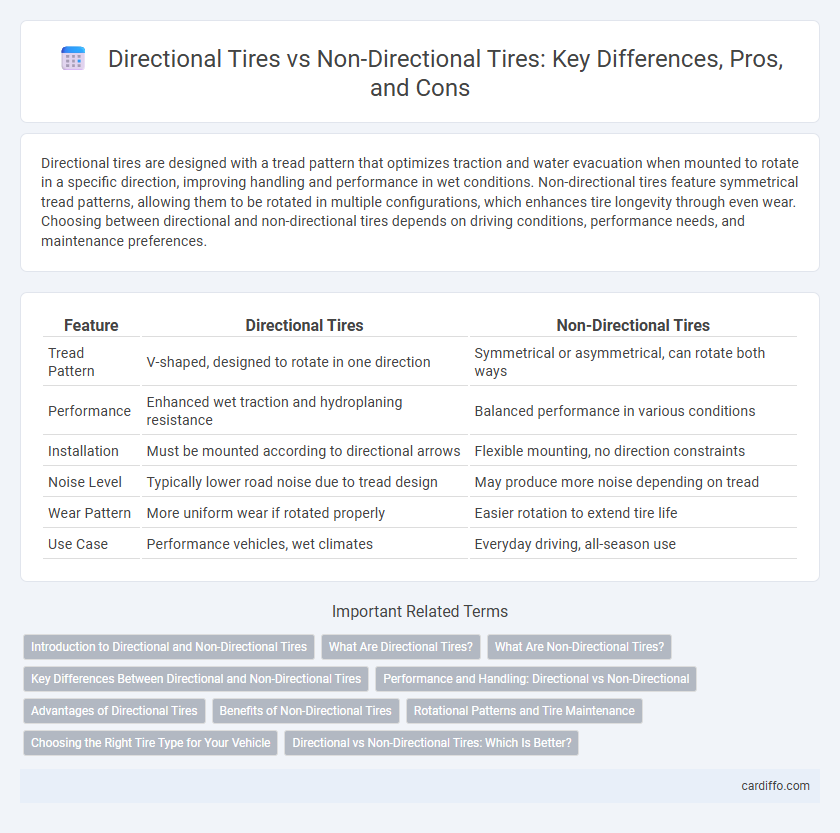Directional tires are designed with a tread pattern that optimizes traction and water evacuation when mounted to rotate in a specific direction, improving handling and performance in wet conditions. Non-directional tires feature symmetrical tread patterns, allowing them to be rotated in multiple configurations, which enhances tire longevity through even wear. Choosing between directional and non-directional tires depends on driving conditions, performance needs, and maintenance preferences.
Table of Comparison
| Feature | Directional Tires | Non-Directional Tires |
|---|---|---|
| Tread Pattern | V-shaped, designed to rotate in one direction | Symmetrical or asymmetrical, can rotate both ways |
| Performance | Enhanced wet traction and hydroplaning resistance | Balanced performance in various conditions |
| Installation | Must be mounted according to directional arrows | Flexible mounting, no direction constraints |
| Noise Level | Typically lower road noise due to tread design | May produce more noise depending on tread |
| Wear Pattern | More uniform wear if rotated properly | Easier rotation to extend tire life |
| Use Case | Performance vehicles, wet climates | Everyday driving, all-season use |
Introduction to Directional and Non-Directional Tires
Directional tires feature a tread pattern designed to rotate in one direction, enhancing water evacuation and improving traction in wet conditions. Non-directional tires have symmetric tread patterns that allow mounting on either side of the vehicle, offering versatility and easier tire rotation. Both types influence vehicle handling, tire wear, and performance based on driving conditions and maintenance practices.
What Are Directional Tires?
Directional tires feature a distinct tread pattern designed to channel water away from the tire's contact patch, enhancing wet traction and reducing hydroplaning risks. Their V-shaped grooves or arrows indicate the single direction of rotation, which improves handling and stability at high speeds. These tires are commonly used on performance vehicles and in conditions requiring optimized grip and precise steering response.
What Are Non-Directional Tires?
Non-directional tires feature a symmetrical tread pattern designed to rotate in any direction, offering flexible mounting options and easier tire rotation for even wear. These tires excel in providing consistent performance on dry and wet roads, making them ideal for everyday driving conditions. Their universal design enhances tire longevity while maintaining reliable traction and handling across various vehicles.
Key Differences Between Directional and Non-Directional Tires
Directional tires feature a tread pattern designed to channel water away, enhancing wet traction and reducing hydroplaning, while non-directional tires have a symmetric tread pattern that allows for easier rotation in multiple positions, promoting even wear. Directional tires must be mounted to rotate in a specific direction for optimal performance and noise reduction, whereas non-directional tires can be mounted on either side without affecting functionality. The use case for directional tires often prioritizes high-speed stability and handling, contrasting with non-directional tires that emphasize versatility and extended tread life.
Performance and Handling: Directional vs Non-Directional
Directional tires offer enhanced wet traction and improved handling due to their tread patterns designed for optimal water evacuation and precise steering response. Non-directional tires provide versatile performance with even tread wear, making them suitable for rotating in multiple positions to extend tire life. In performance scenarios, directional tires excel in high-speed stability and cornering, while non-directional tires deliver reliable, consistent handling across varied road conditions.
Advantages of Directional Tires
Directional tires provide superior traction and handling on wet or slippery roads due to their unique tread pattern that efficiently channels water away from the contact patch. Their design enhances high-speed stability and cornering performance, making them ideal for performance vehicles and aggressive driving conditions. This optimized water evacuation and improved grip contribute to increased safety and control in adverse weather, outperforming non-directional tires in wet conditions.
Benefits of Non-Directional Tires
Non-directional tires offer the benefit of being mountable on any side of the vehicle, enhancing tire rotation flexibility and promoting even tread wear, which extends tire lifespan. These tires provide consistent performance in various driving conditions without the need to match specific rotation patterns. Their versatility simplifies tire maintenance and reduces replacement costs by maximizing tread utilization.
Rotational Patterns and Tire Maintenance
Directional tires feature a V-shaped tread pattern designed to enhance water dispersion and improve traction by rotating in a single direction, which requires careful alignment during installation to maintain optimal performance. Non-directional tires have a symmetrical tread pattern that allows them to be rotated in various configurations, promoting even tread wear and extending tire lifespan through flexible maintenance options. Proper tire maintenance involves regular rotation tailored to the tire type, ensuring balanced wear, maintaining traction, and maximizing safety and efficiency on the road.
Choosing the Right Tire Type for Your Vehicle
Directional tires offer superior performance in wet conditions and high-speed stability due to their V-shaped tread patterns designed for one-way rotation. Non-directional tires provide greater flexibility in mounting and often last longer by allowing rotation in multiple directions, which helps balance wear. Selecting the right tire type depends on your driving habits, weather conditions, and vehicle requirements to ensure optimal traction and safety.
Directional vs Non-Directional Tires: Which Is Better?
Directional tires offer enhanced wet traction and better handling at high speeds due to their tread design optimized for forward rotation, making them ideal for performance driving and wet conditions. Non-directional tires provide more flexible mounting options and generally have longer tread life, which can be beneficial for everyday driving and ease of tire rotation. Choosing between directional and non-directional tires depends on driving habits, road conditions, and maintenance preferences, with directional tires favored for performance and safety in wet weather while non-directional tires prioritize versatility and tire longevity.
Directional tires vs Non-directional tires Infographic

 cardiffo.com
cardiffo.com